III. Intimate Landscapes in Uzbekistan
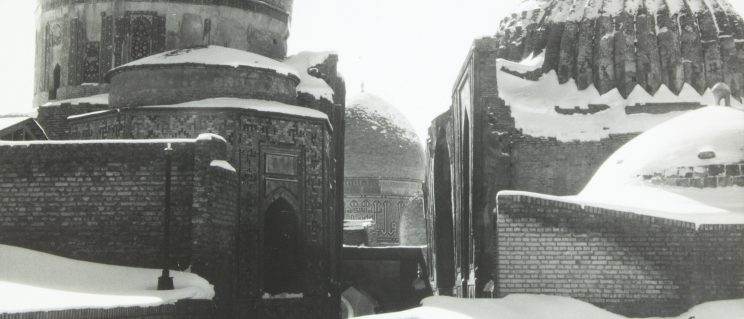

Beyond the River
Transoxiana was the name the ancients gave to the area that now includes Uzbekistan, i.e., Central Asia north of the Oxus, that once great river now known as the Amu Darya. In the fifth century BCE, this was part of the Achaemenid Empire under Darius I. The Greeks called the area Sogdiana and united it with Bactria. Later it also was known as Ma waraʾ al-nahr, which means “beyond the river” in Arabic. With few natural defenses, this immense area stretching from the Oxus to the broad Siberian steppes was subject to repeated invasions by nomadic tribes. Among the Turkic tribes that came to dominate, ancestry was important, often decisive, in the selection of leaders. In his memoirs, Babur refers to the large province of Samarkand as Transoxiana and states that it “was supposed to have been built by Alexander.”
Caravan routes formed the link between settlements that developed around oases like Bukhara. The swift Arab expansion that swept across the Iranian plateau in the seventh century stalled at Bukhara, but by the year 1000 CE, Arabic had become the official language, and most of the population of Transoxiana was Muslim. When the Samanids gained power, Persian became the official language, but variations of Turkic remained the common spoken language. Rituals of Siberian shamanism, widely practiced during the Archaic period, were slow to disappear among the Central Asians, although they absorbed other customs and beliefs, including Buddhism and, later, Islam.
In 1220, Genghis Khan sacked Bukhara, and all of Central Asia became part of the vast territory he controlled. When Genghis died in 1227, his huge Mongol Empire was divided, and Transoxiana passed to his second son, Chaghatai. In 1370, Timur, a brilliant, driven, and ruthless Turk, emerged from obscurity, united the warrior tribes opposed to the Mongols, and seized control of Transoxiana. By his death in 1405, Timur had rebuilt Samarkand, the capital of his empire, transforming it into a gloriously tiled city, replete with plunder from his foreign conquests (figs. 1a–1e).
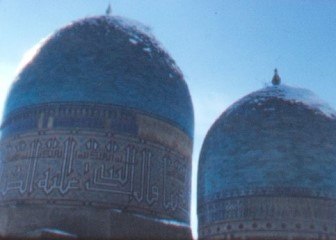
Image 1 of 8

Image 2 of 8

Image 3 of 8

Image 4 of 8
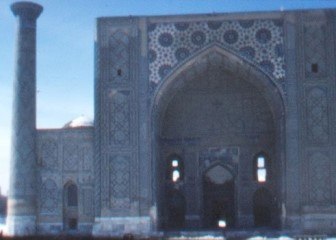
Image 5 of 8

Image 6 of 8
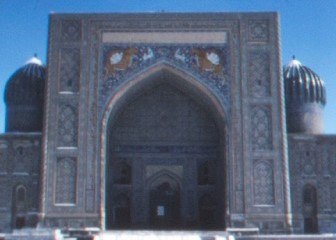
Image 7 of 8

Image 8 of 8
1a–1e. Views of Uzbekistan. Elizabeth Moynihan Collection.
The fertile Ferghana Valley, toward the eastern edge of Transoxiana, was known for little other than the heavenly horses raised there and so prized by the rulers of China. In 1484, Ferghana’s ruler fell to his death when the dovecote where he visited his pet birds fell from the edge of a cliff into a deep ravine, and the realm passed to his twelve-year-old son, Zahir‘ud-din Muhammad Babur (1483–1530). The boy was a fifth-generation descendant of Timur through his father and a sixteenth-generation descendant of Genghis Khan through his mother, the daughter of Yunus Khan, the educated and exceptional leader of the Chaghatai Mongols.
The Great Prize
On the day his father died, two of Babur’s uncles were preparing to attack Ferghana and take control. With no time for mourning, Babur was whisked off to safety by begs loyal to his father; he learned immediately he had to survive by the sword and in the saddle, and to live on the edge. Timur had dozens of descendants who fought with and tricked each other in the unstable political world of Transoxiana, but the great prize each hungered for was Samarkand. Babur exulted about the city in the Baburnama: “Few cities in the civilized world are as pleasant as Samarkand.” (Baburnama, f. 44b)
The first time Babur took Samarkand, in 1492, it was almost accidental. The throne suddenly became unoccupied. Babur joined the claimants laying siege, but his cousins were so distracted that the cocksure, young risk taker slipped in and took the prize. Babur was fourteen years old. He didn’t hold the city long, only three months: when his mother and grandmother in Ferghana came under attack and desperately sought his help, he rushed back to the fort in Andizhan (Andijan). He arrived too late; the women had fled. Disheartened and discouraged, he wrote, “We had lost Samarkand for the sake of Andizhan, and now Andizhan too was lost. Taken unawares, we were, as the saying goes, ‘driven from pillar to post’” (Baburnama, f. 54).
Five years later, in November 1497, he tried again to take Samarkand and was successful. Babur exclaimed:
For nearly 140 years the capital Samarkand had been in our family. Then came the Uzbeks, the foreign foe from God knows where, and [they] took over. Now the property that had slipped from our hands had been restored by God. The plundered and pillaged kingdom once again returned to us. (Baburnama, f. 85)
In his characteristic orderly way, Babur had the ramparts of the walled town measured and recorded that they came to a total of ten thousand, seven hundred paces: “The city of Samarkand is an amazingly ornamented city” (Baburnama, f. 47b). He particularly admired Timur’s mosque and Ulugh Beg Mirza’s madrasa and noted that “most of the stonemasons sent from Hindustan worked there” (Baburnama, f. 45b). He was dazzled by Samarkand and described with particular interest the gardens and the famous meadows surrounding the city. His favorite garden had been built in 1451:
During the time of Sultan Ahmad Mirza [Babur’s grandfather], men of high rank and low constructed many gardens, large and small. For pleasure, good air, and [a] superb vista, few are like Darwesh Muhammad Tarkhan’s charbagh [four-garden layout]. It is situated below the Bagh-i-Maydan on a rise overlooking the Qolba Meadow, so that the entire meadow lies stretched our below it. Planted in straight lines in the charbagh are beautiful ornamental trees, cypresses, and poplars. It is truly a magnificent spot, the only flaw being the lack of a good stream. (Baburnama, f. 47b)
Babur was now nineteen, but this passage confirms he already had the archetype of his ideal garden firmly in mind. It was the lifelong standard by which he judged gardens: a great site with a spring or a stream, then terrace above terrace symmetrically laid out, making the most of the water source. He also encouraged high-ranking begs and followers to create gardens.
He could not hold the city. Following a humiliating defeat, he abandoned Samarkand after one hundred days. He then faced the harshest period of his life: his followers left with their troops, and he had to live off the land in the mountains in severe weather. Only his pleasure in the natural world lifted his spirits as this incident during melon season illustrates:
In Nasukh is a kind of melon called Ismaʿil-Shaykhi. It has a yellow skin as soft as glove leather, seeds like an apple’s, and flesh four fingers thick: it is amazingly delicious. There are no other melons like it in those parts. (Baburnama, f. 56)
1978: Following Babur

Babur wrote that the cold in Samarkand could be extreme, and that is how my daughter, Maura, and I found it in February 1978 when we arrived from Tashkent—bone-chilling cold (fig. 2). Fortunately, it was a sunny day, and we were immediately struck by the brilliance of that famously strong light. This was the second leg of a trip to continue research for the book I was writing on Persian and Mughal gardens. Maura took a semester’s leave from Harvard to join me in Tehran; then we flew to Kabul for a brief stay before moving on to Uzbekistan. My plan was to follow Babur’s route from Central Asia, where he spent his youth, and Kabul, where he ruled, to India, which he invaded, and Agra, where he established the Mughal dynasty.
We arrived in Samarkand and found we had no hope of finding a garden site Babur might have seen. If any had survived from the beginning of the sixteenth century, they did not survive the Soviet era. We were pleased to see the scant remains of Ulugh Beg Mirza’s observatory; it had served as a model for astronomical observatories built by Jai Singh II of Jaipur in 1781–34, with which we were familiar.
When we walked around Registan Square, opposite Ulugh Beg Mirza’s madrasa, there was no trace of the 1941 archaeological excavations that had unearthed a garden, a water system with ceramic pipes, and brick and marble paving in what had been the school’s garden forecourt. In 1500, when Babur was under siege in Samarkand, he pitched tents on Ulugh Beg’s roof and established his quarters there, which gave him a view over the center of town.
In her monograph on Timurid gardens, Galina A. Pugachenkova described the excavation of the madrasa forecourt. Based on her research, she’d concluded that the fifteenth-century gardens of Central Asia had
a strictly established plan, based on a system of geometrically structured axes (two or more) issuing from a single point, which was the owner’s palace or house, and being characterized by a picturesque freedom of intimate landscapes within the confines of this specific plan, which included clumps of trees. Architecture, vegetation, and water supplement each other harmoniously, combining garden, pool, palace and pavilions into one organic whole.

I looked forward to my appointment with Dr. Pugachenkova the following week in Tashkent.
Seeking what Babur would have seen, Maura and I visited Timur’s mosque (fig. 3) and his tomb, the Gur-Amir, and the remains of Ulugh Beg’s observatory and saw the stunning tile work on the Shah-i-Zinda (fig. 4). We tried to see places Babur mentioned, but Tarkhan’s charbagh was long gone, and we could identify only the reduced sites of a few meadows from the many that Timur built and had once ringed the city. We were surprised to find the Gur-Amir was in a residential neighborhood rather than on a grand plaza. On the path in front of the tomb some young children were struggling with a sled, so Maura lifted them on and pulled the sled producing delighted laughter, several adults emerged, scolded the children and sent us away. They were quite a contrast to the villagers in Istalif, Afghanistan, who were so open and friendly.
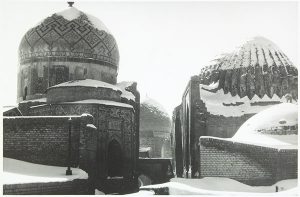
Dr. Pugachenkova listed fourteen gardens in Samarkand, including the Dilkusha (Happy Heart), which Timur laid out in 1378 for his twelve-year-old bride. Pugachenkova claimed that Timur had planned the gardens personally, lived “like a guest” in painted garden pavilions, and moved frequently between gardens. They were actually encampments that enclosed huge meadows that surrounded Samarkand.
The New Garden
The only known description of Samarkand by a visitor during Timur’s time is by Ruy González de Clavijo, who in 1403 led an embassy there from Henry III of Spain. There were roughly one hundred years between the Spanish embassy and Babur’s adventures in Samarkand, but the emperor saw some of the gardens Clavijo visited. The Spaniard recorded helpful descriptions of the gardens’ extensive water systems and noted that the garden plots were repeatedly quartered, but he also described how they were used by Timur, his family, and the court. During his embassy, Clavijo was housed at the Bagh-i-Naw, the New Garden, which he described as follows:
This orchard was surrounded by a high wall, four square, enclosing it, and at each of the four corners was a very lofty round tower, and the enclosing wall going from tower to tower was very high built, and a strong as the work of the tower.
These words could describe the Mughal garden enclosures created by Timur’s descendants—from Humayun’s tomb, completed in 1573, to the garden at Pinjore [link to Pinjore section] completed in 1680—that survive in India today.
Babur knew the New Garden very well; that was where he prepared for a major encounter with Muhammad Khan Shaybani (1451–1510), leader of the Uzbeks, in 1501, near the end of his second occupation of Samarkand:
We stayed in the Bagh-i-Naw for five or six days to gather our forces and make ready. Riding from there we proceeded, march by march, and camped past Sar-i-Pul. We fortified the perimeter of the camp with pylons and trenches. (Baburnama, f. 88)
Babur’s undisciplined force was much smaller than that of Shaybani, whose men were seasoned fighters; Babur lost the battle by the river and barely escaped:
Reaching the river, we plunged right in with mail and horse armor. A bit more than halfway across, the horses could reach the bottom, but after that it was too deep, and for an arrow shot we in full mail had to make the armored horses swim. Once across we cut off the horses’ armor and ditched it. (Baburnama, f. 90)
On foot and soaking wet, Babur made it inside the walls and to the citadel, where he withstood a five-month siege: “Some great begs and superb warriors … were lost in this battle.” (Baburnama, f. 90b)
The siege of Samarkand was long, and because starvation was certain, Babur was forced to surrender the city to the Uzbeks. It was so humiliating, he never fully explained it in the Baburnama, which is surprising, because he was usually so forthcoming and candid.
Accepting military support from the Persian shah Ismail, Babur took Samarkand for a third time. However, he faced constant hostility from the residents, who were against the alliance with the Shi’a and he held it for only eight months. He never returned.
A Passion for Gardens
On the flight back to Tashkent through Bukhara, Maura and I could see endless miles of cotton fields, but we couldn’t see the Aral Sea because its shoreline had diminished by fifty miles and the great Amu Darya River was so depleted, it disappeared long before it reached the Aral Sea. Today the sea itself has been destroyed by the over-irrigation of those endless acres of cotton fields.
In Tashkent, our Intourist handler was always present; we wondered if she slept in the hotel lobby, because when we stepped out of the elevator, she was right there to greet us. The Russian floor matron no doubt informed her when we left our room. Our guide became very excited when a TV crew interviewed me as Pravda’s “Tourist of the Month.” It was not very successful, however, because on camera I preferred the old, low bungalows to the blocks and blocks of identical Soviet high-rise buildings. The interview ended when I admired the Uzbek girls multi-plaited hairstyles and dark, curving eyebrows.

It was winter, and we were practically the only tourists (fig. 5). Most guests at the hotel were Soviet students or drunken, traveling businessmen; the consumption of vodka was astounding. There was no room service, and we were harassed in the dining room. We could eat there only when we were escorted by an Afghan pilot we’d met in Kabul; he had been trained in Texas. He also accompanied us to the bird market, where handmade cages held a variety of lovely song birds. Otherwise, the bazaar had little to offer and was dull compared to Kabul, but we bought a delicious melon for Maura, a vegetarian, and kept it from spoiling by hanging it outside the window of our hotel room.
I met Galina A. Pugachenkova at the Tashkent Museum; she was gracious, attractive, and fortunately spoke English very well. She was enthusiastic about Babur and some years earlier had done considerable research on Ulugh Beg’s gardens, but unfortunately she did not have anything to add about Babur. Instead, she was most eager to hear about the Kabul Museum and particularly interested in the exquisite Indian ivories that I’d seen there in an exhibition of ancient Kushan art.
Dr. Pugachenkova had considerable knowledge of Central Asian flowers and gardening traditions and had drawn conjectural plans of an old charbagh, which she gave to me. However, it was Constance Villiers-Stuart who made a definite connection between Babur and the Central Asian love of flowers in Gardens of the Great Mughals:
Babur, as we have seen, was the first to introduce the Central Asian irrigated garden into India. But although the comparatively late date of 1530 marks that epoch in Indian art and garden history, the early Buddhist source of the Turki love of flowers and garden design has been most curiously brought to light by the discoveries of Sir Aurel Stein.
I would like to know where Mrs. Stuart learned about “the Central Asian irrigated garden.” So far, I’ve not been able to track down such a reference.
Although Mrs. Stuart and Aurel Stein were in India at the same time, it is not clear that they ever met. Stein may have been traveling when Mrs. Stuart lived there. But she read, and obviously enjoyed, his 1904 book, Sand-Buried Ruins of Khotan, and referred to it when discussing the Central Asian passion for flowers and the garden at Yarkand, where Stein camped during his expedition. Those of us who find Babur and his view of the natural world interesting all seem to share an interest in Aurel Stein and the discoveries he made as he followed the Silk Road.
I am intrigued by Stein’s description of the spirited drawing in the small frescoes on the cella wall of the Buddhist shrine he uncovered at Dandan Uiliq:
The delineation of the lotus flowers which rise from the tank to a variety of forms closed or half open, as well as their colours, ranging from dark blue to deep purple, seemed remarkably true to nature and distinctly suggested that these sacred flowers were familiar to the painter from personal observation.
Then Stein connected the Buddhist frescoes to the native blue Lotus of Kashmir.:
I feel convinced that already ancient Khotan had known the graceful plant dear to the gods of India … it needs no effort of imagination to believe that the lotuses that once adorned the gardens of settlements now buried by the desert sand were originally derived from the great Himalayan Valley, on the lakes of which I had so often admired them.
Stein next shed some light on the most interesting question—the form of the Central Asian garden:
A very curious feature of this ruin was the clearness with which the arrangement of the adjoining garden could be traced. The trunks of the poplars, which still rise 8 to 10 feet from the original surface and are thus clearly visible above the drift-sand, are grouped in the same little squares and enclosing rectangular avenues which can be seen in every well-kept “Boston” [grove] from Kashgar to Keriya. The trees were planted at regular distances, which are marked on my plan. The hedgerow or rush fence enclosing the garden was also mostly intact though covered in parts by the sand.
While examining ruins beyond Niya, Stein was covered with a light spray of sand as he stood on greatly eroded ground among the dunes. As he collected his specimens from the withered trees of the ancient, sand-dusted orchards, he was already planning his next expedition—to the buried Buddhist sites in Turkestan. He grabbed my attention when he exclaimed:
Where will it be next that I can walk amidst poplars and fruit trees planted when the Caesars still ruled in Rome and the knowledge of Greek writing had barely vanished on the Indus?
I hope an archaeologist with a passion for garden history will follow this great man’s route and learn about Central Asian gardens.

